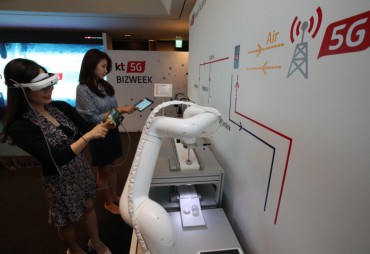
SK hynix CEO Lee Seok-hee speaks to reporters following an event hosted by the Korea Semiconductor Industry Association in Seoul on Oct. 29, 2020. (Yonhap)
SEOUL, Nov. 4 (Korea Bizwire) — SK hynix Inc., South Korea’s second-largest chipmaker, aims to triple its NAND flash sales in the next five years with the acquisition of Intel Corp.’s non-volatile memory business unit, its CEO said Wednesday.
In a rare conference call appearance, SK hynix CEO Lee Seok-hee explained the company’s 10.3 trillion-won (US$9 billion) deal to buy Intel’s NAND flash unit, which includes U.S. chip giant’s solid state drive (SSD) business and a NAND flash chip plant in Dalian, China.
“The company will secure self-sustainable business strength in NAND within the next three years and grow SK hynix’s NAND revenue to triple that of before the acquisition in the next five years,” Lee said.
“With this effort, we will try to do our best to earn recognition as the top memory player, not only a DRAM leader.”
Last year, SK hynix’s NAND business made 5.1 trillion won, or 19 percent of the company’s 27 trillion-won revenue.
Intel’s non-volatile memory solution business, meanwhile, generated $4.4 billion revenue in 2019.
“SK hynix acquired Intel’s NAND memory and storage business in order to swiftly secure leading SSD technology and diversify its product portfolio,” he added.
“With this acquisition the Company seeks to establish a balanced business structure between DRAM and NAND flash.”
Lee, a former Intel man who worked for the U.S. firm between 2000 and 2010, emphasized that the industry is at a turning point and that demand for SSDs will soar in the future.
SK hynix expected that global data center storage to grow from 0.9 billion terabytes (TB) this year to 5.1 billion TB in 2030, with the portion of SSDs rising from 10 percent to 43 percent over the period.
Lee said the deal, which will make SK hynix the No. 2 NAND flash player in the market, will deliver diversified products to customers and establish technology leadership in the sector.
Intel is known to have advanced controller and firmware technologies, as well as a quadruple level cell (QLC) NAND flash architecture solution.
Lee said Intel’s Chinese plant will focus on cold data storage, which holds data that are not used frequently, with its floating gate technology, while SK hynix’s domestic facility will maintain its charge trap-based production to deal with hot data storage and mobile sectors.

This undated photo provided by SK hynix Inc. shows workers at the company’s chip plant in Icheon, south of Seoul.
To make the best use of Intel’s technology assets, Lee said the company will focus on retaining Intel’s key research and development workforce.
“Retention of key talents can determine success and failure of acquisition,” he said. “We do have a mechanism in place in the contract to have the retention of key personnel. We will not rush into consolidation.”
Under the deal, SK hynix will have to pay $7 billion to Intel by late 2021 and give the remaining $2 billion by March 2025.
While there have been concerns about SK hynix paying a lump sum of money, Lee said the company is confident of financing the deal.
“Half of the payment can be prepared with our cashable assets and future cash flows,” he added. “We will consider the remaining payments with options including borrowings and asset liquidation.”
There has been speculation that SK hynix might sell its stake in Japan’s Kioxia Corp., currently the world’s No. 2 NAND flash supplier, to acquire funds for the deal, but the company reiterated that such a move may not happen at least for the time being.
In 2017, SK hynix joined a global consortium to invest in Kioxia, then known as Toshiba Memory Corporation Corp., and injected about 4 trillion won. The consortium, which includes Apple and Bain Capital, now has a 49.9 percent stake in Kioxia.
“We could review the Kioxia plan, but that investment was made with a long-term perspective,” said Cha Jin-seok, the chief finance officer of SK hynix. “There is no need to rush to sell the stake in Kioxia.”
(Yonhap)






